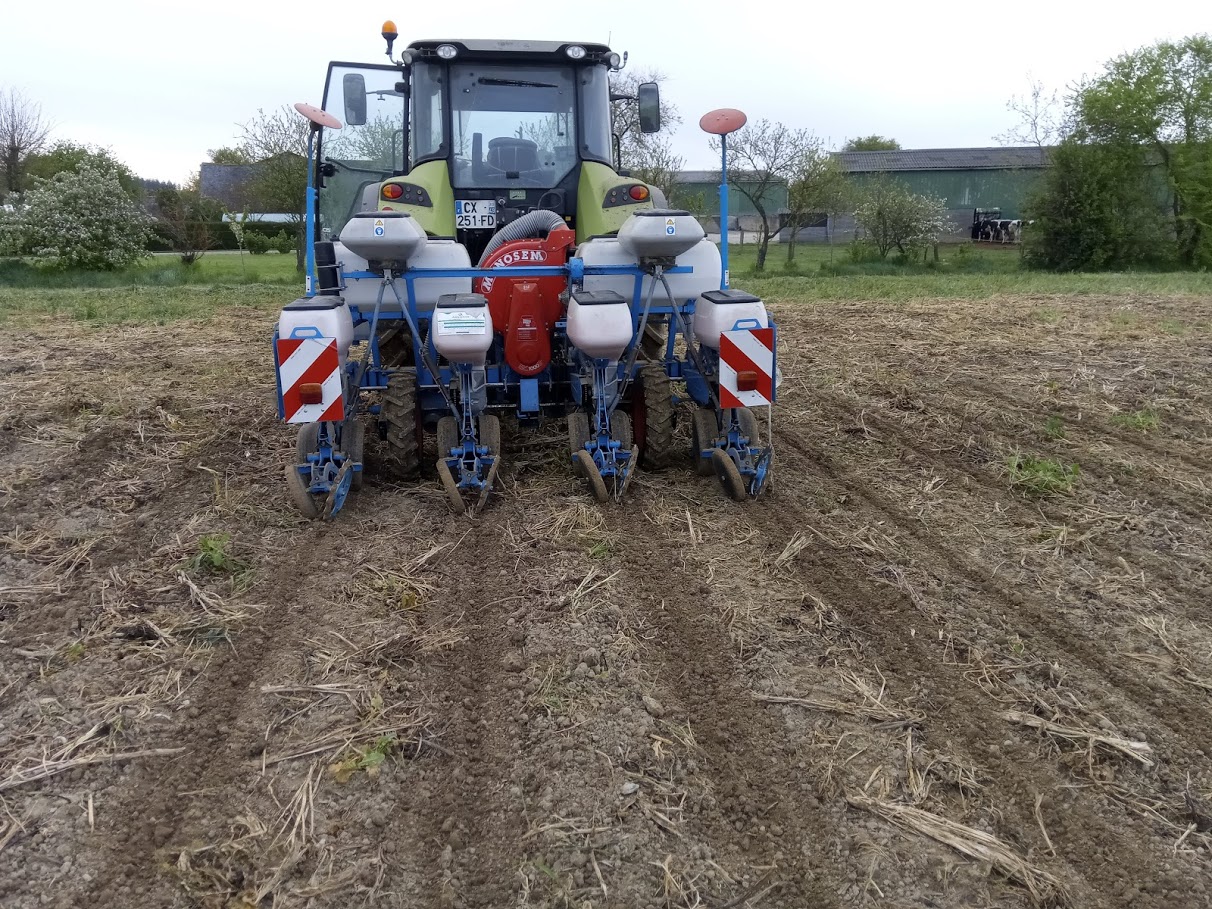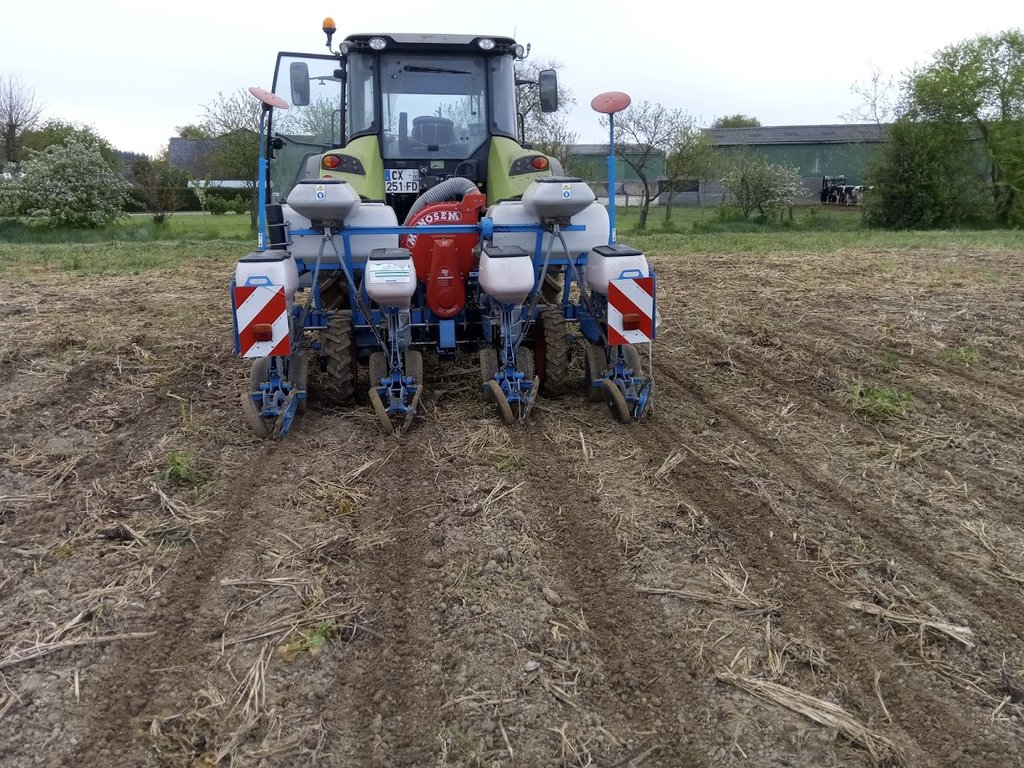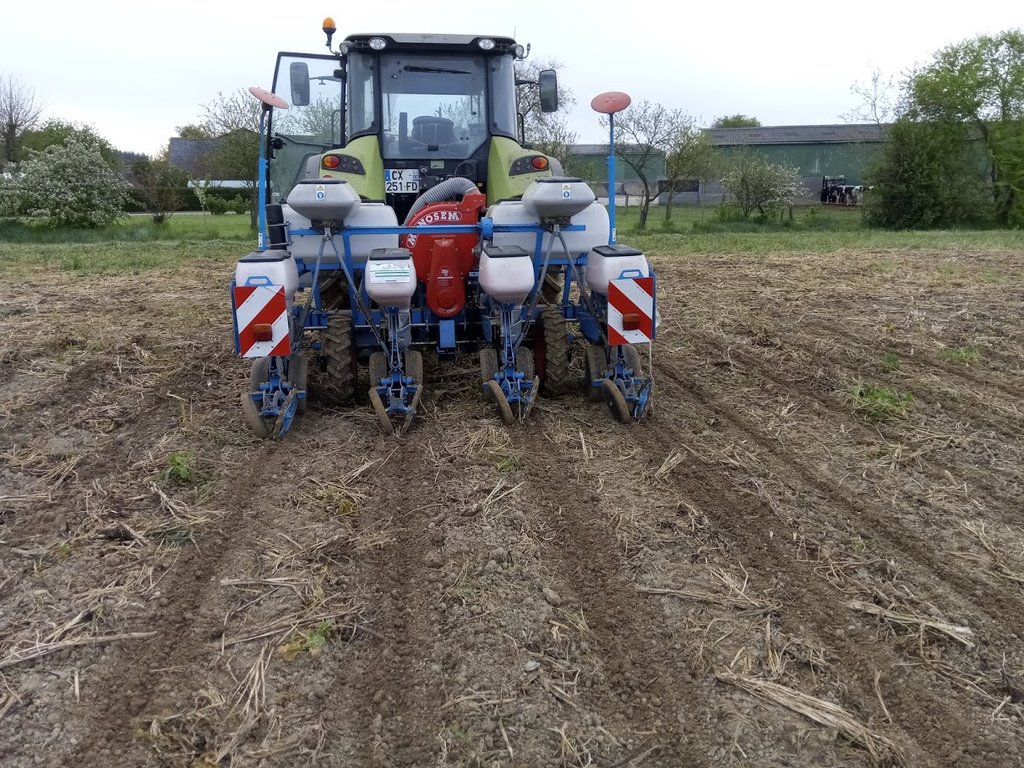Rotation 2+2 of cereals in a no-tillage system [法国]
- 创建:
- 更新:
- 编制者: Alan Radbourne
- 编辑者: David Robinson, David Norris, Sabine Reinsch
- 审查者: Rima Mekdaschi Studer, William Critchley
Rotation 2+2
technologies_5678 - 法国
查看章节
全部展开 全部收起1. 一般信息
1.2 参与该技术评估和文件编制的资源人员和机构的联系方式
关键资源人
co-compiler:
Faure Marie-Line
Chamber of Agriculture of Pays de Loire
法国
土地使用者:
Colineau Denis
Gaec Des Emeraudes
法国
co-compiler:
Drouet Baptiste
Chamber of Agriculture of Pays de Loire
法国
有助于对技术进行记录/评估的项目名称(如相关)
European Interreg project FABulous Farmers有助于对技术进行记录/评估的机构名称(如相关)
UK Centre for Ecology & Hydrology (CEH) - 英国有助于对技术进行记录/评估的机构名称(如相关)
Association des Chambres d’agriculture de l’Arc Atlantique (AC3A) - 法国1.3 关于使用通过WOCAT记录的数据的条件
编制者和关键资源人员接受有关使用通过WOCAT记录数据的条件。:
是
1.4 所述技术的可持续性声明
这里所描述的技术在土地退化方面是否存在问题,导致无法被认为是一种可持续的土地管理技术?:
否
2. SLM技术的说明
2.1 技术简介
技术定义:
A trial crop rotation system of '2+2', where a succession of two spring crops (maize) followed by two winter crops (wheat) aims to diversify cropping through rotation (sequences and intervals) while limiting weed pressure under a no-tillage system.
2.2 技术的详细说明
说明:
The region Pays de Loire in Western France has a temperate climate with warm summers and mild winters. The region has many rural areas, dedicated mostly to agriculture with large economic centres and urban conurbations (e.g. the Nantes area). The rotation 2+2 technology is being applied on a dairy farm in Pays de Loire (La Pouëze), implementing Soil Conservation Agriculture. Fields have not been ploughed for 9 years and direct seeding of cover crops (primarily clover that is cut as green mulch, although may be cut for silage) and winter crops has been used for 4 years.
The rotation Maize/Wheat/Maize/Wheat was changed to a Maize/Maize/Wheat/Wheat rotation (2+2). In the traditional rotation Maize/Wheat/Maize/Wheat, there were 2 sequences (wheat followed by maize and maize followed by wheat) and 1 interval cover cropping (every two years). In the new 2+2 rotation Maize/Maize/Wheat/Wheat, the crops in the rotation are not changed but the number of sequences is doubled (4 sequences: wheat/wheat; maize/maize; wheat/maize; maize/wheat) and there are 2 cover cropping intervals (years 0 & 3) instead of one. This 4 year cycle can then be repeated. This modification allows more diversity in the rotation including variation in timing of the cover crops (some long gaps between wheat and maize, some short between wheat and wheat) and, in our no tillage system, helps to limit weed pressure on both crops.
In a no-tillage system, keeping weed seeds on the surface exposes them to climatic hazards and predators. Thus in this new system regime, during the two years of maize, the wheat weed seeds are neither in optimal conditions for dormancy, nor in optimal conditions for germination, which decreases the stock of seeds of wheat weeds. Thus in our no tillage system, the weed pressure (including resistant rye grass) has been significantly reduced.
The 2+2 rotation improved production, reduced/prevented land degradation and reduced weed pressure.
Initial investment costs are limited to purchasing the management equipment.
Benefits of the 2+2 rotation include:
Increased: crop production, farm income, water drainage, nutrient cycling, soil organic matter carbon, vegetation cover, beneficial species, habitat diversity
Reduced: risk of production failure, workload/time, fuel surface water runoff, evaporation, soil crusting, soil compaction, impact on soil life, weed emergence
The compilation of this SLM technology is a part of the European Interreg project FABulous Farmers which aims to reduce the reliance on external inputs by encouraging the use of methods and interventions that increase the farm’s Functional AgroBiodiversity (FAB). Visit www.fabulousfarmers.eu and www.nweurope.eu/Fabulous-Farmers for more information.
2.3 技术照片
2.4 技术视频
注释、简短说明:
None available.
2.5 已应用该技术的、本评估所涵盖的国家/地区/地点
国家:
法国
区域/州/省:
Pays de la Loire
有关地点的进一步说明:
La Pouëze
具体说明该技术的分布:
- 均匀地分布在一个区域
如果不知道精确的区域,请注明大致覆盖的区域:
- 0.1-1 平方千米
技术现场是否位于永久保护区?:
否
Map
×2.6 实施日期
如果不知道确切的年份,请说明大概的日期:
- 不到10年前(最近)
2.7 技术介绍
详细说明该技术是如何引入的:
- 通过土地使用者的创新
- 通过项目/外部干预
注释(项目类型等):
Soil training sessions, trade fairs and farmers groups have supported the land user's innovation
3. SLM技术的分类
3.1 该技术的主要目的
- 改良生产
- 减少、预防、恢复土地退化
- reduced weed pressure
3.2 应用该技术的当前土地利用类型
同一土地单元内混合使用的土地::
否

农田
- 一年一作
年作 - 具体指明作物:
- 谷物类 - 玉米
- 谷类 - 小麦(冬季)
每年的生长季节数:
- 1
采用间作制度了吗?:
否
采用轮作制度了吗?:
是
如果是,请具体说明:
Maize/Maize/Wheat/Wheat
3.3 由于技术的实施,土地使用是否发生了变化?
由于技术的实施,土地使用是否发生了变化?:
- 否(继续问题3.4)
3.4 供水
该技术所应用土地的供水:
- 雨养
3.5 该技术所属的SLM组
- 轮作制度(轮作、休耕、轮垦)
- 改良的地面/植被覆盖
- 最小的土壤扰动
3.6 包含该技术的可持续土地管理措施

农艺措施
- A1:植被和土壤覆盖层
- A2:有机质/土壤肥力
- A3:土壤表面处理
3.7 该技术强调的主要土地退化类型

土壤水蚀
- Wt:表土流失/地表侵蚀

化学性土壤退化
- Cn:肥力下降和有机质含量下降(非侵蚀所致)

物理性土壤退化
- Pc:压实

生物性退化
- Bl:土壤寿命损失
- Bp:害虫/疾病增加,捕食者减少
3.8 防止、减少或恢复土地退化
具体数量名该技术与土地退化有关的目标:
- 减少土地退化
4. 技术规范、实施活动、投入和成本
4.1 该技术的技术图纸
技术规范(与技术图纸相关):
Keeping the crop distribution (overall area of maize and wheat at farm scale unchanged), the rotation 2+2 allows more resiliance in the sequences of the no-tillage system, helping to control weeds.
作者:
Baptiste Drouet
日期:
12/12/2019
4.2 有关投入和成本计算的一般信息
具体说明成本和投入是如何计算的:
- 每个技术区域
注明尺寸和面积单位:
1 ha
如果使用本地面积单位,注明转换系数为1公顷(例如1公顷=2.47英亩):1公顷=:
1 ha = 2.47 acres
其它/国家货币(具体说明):
€
如相关,注明美元与当地货币的汇率(例如1美元=79.9巴西雷亚尔):1美元=:
0.9
注明雇用劳工的每日平均工资成本:
Not known
4.3 技术建立活动
注释:
No extra establishment activities or costs as technology relates to the ongoing management and rotational planting of crops.
4.4 技术建立所需要的费用和投入
注释:
No establishment activites or costs as technology relates to the ongoing management and rotational planting of crops.
4.5 维护/经常性活动
| 活动 | 时间/频率 | |
|---|---|---|
| 1. | Seed drill + roller for wheat and cover crop | Each wheat cropping and cover crop season |
| 2. | Strip-Till before maize seeding | Each maize cropping season |
| 3. | Fungicide | During the production cycle (month 2-3 for wheat and 1-2 for maize) |
| 4. | Herbicide | Before, during and after crop production |
| 5. | Fertizlier input | During wheat and maize crop |
| 6. | Manure input | Before maize crop |
| 7. | Wheat harvest | June/July |
| 8. | Maize harvest | October/November |
4.6 维护/经常性活动所需要的费用和投入(每年)
| 对投入进行具体说明 | 单位 | 数量 | 单位成本 | 每项投入的总成本 | 土地使用者承担的成本% | |
|---|---|---|---|---|---|---|
| 劳动力 | Workforce | person days per ha | 2.0 | 200.0 | 400.0 | 100.0 |
| 设备 | Seeder + roll for wheat and cover crops | 1ha/yr | 1.0 | 35.0 | 35.0 | 100.0 |
| 设备 | Strip till for maize | 1ha/yr | 1.0 | 25.0 | 25.0 | 100.0 |
| 设备 | Pneumatic drill for maize | 1ha/yr | 1.0 | 18.0 | 18.0 | 100.0 |
| 植物材料 | Wheat seeds (4 year cycle) | 1ha/yr | 1.0 | 15.0 | 15.0 | 100.0 |
| 植物材料 | Maize seeds (4 year cycle) | 1ha/yr | 1.0 | 30.0 | 30.0 | 100.0 |
| 植物材料 | Cover crop seeds (4 year cycle) | 1ha/yr | 1.0 | 5.0 | 5.0 | 100.0 |
| 肥料和杀菌剂 | Fungicide (1 maize + 1 wheat - 4 year cycle) | 1ha/yr | 1.0 | 12.0 | 12.0 | 100.0 |
| 肥料和杀菌剂 | Herbicide (1 maize + 1 wheat - 4 year cycle) | 1ha/yr | 1.0 | 10.0 | 10.0 | 100.0 |
| 肥料和杀菌剂 | Fertiliser (1 maize + 1 wheat - 4 year cycle) | 1ha/yr | 1.0 | 70.0 | 70.0 | 100.0 |
| 肥料和杀菌剂 | Manure (1 maize - 4 year cycle) | 1ha/yr | 1.0 | 5.0 | 5.0 | 100.0 |
| 技术维护所需总成本 | 625.0 | |||||
| 技术维护总成本,美元 | 694.44 | |||||
注释:
On a 4 year rotation cycle, costs amount to approx. 2500€ per ha.
4.7 影响成本的最重要因素
描述影响成本的最决定性因素:
There is no change in cost between the initial rotation (wheat-maize-wheat-maize) and the rotation 2+2.
5. 自然和人文环境
5.1 气候
年降雨量
- < 250毫米
- 251-500毫米
- 501-750毫米
- 751-1,000毫米
- 1,001-1,500毫米
- 1,501-2,000毫米
- 2,001-3,000毫米
- 3,001-4,000毫米
- > 4,000毫米
指定年平均降雨量(若已知),单位为mm:
650.00
有关降雨的规范/注释:
Mild and rainy winter, hot dry summer (lately)
注明所考虑的参考气象站名称:
Beaucouzé meteorological station
农业气候带
- 半湿润
5.2 地形
平均坡度:
- 水平(0-2%)
- 缓降(3-5%)
- 平缓(6-10%)
- 滚坡(11-15%)
- 崎岖(16-30%)
- 陡峭(31-60%)
- 非常陡峭(>60%)
地形:
- 高原/平原
- 山脊
- 山坡
- 山地斜坡
- 麓坡
- 谷底
垂直分布带:
- 0-100 m a.s.l.
- 101-500 m a.s.l.
- 501-1,000 m a.s.l.
- 1,001-1,500 m a.s.l.
- 1,501-2,000 m a.s.l.
- 2,001-2,500 m a.s.l.
- 2,501-3,000 m a.s.l.
- 3,001-4,000 m a.s.l.
- > 4,000 m a.s.l.
说明该技术是否专门应用于:
- 不相关
5.3 土壤
平均土层深度:
- 非常浅(0-20厘米)
- 浅(21-50厘米)
- 中等深度(51-80厘米)
- 深(81-120厘米)
- 非常深(> 120厘米)
土壤质地(表土):
- 中粒(壤土、粉土)
土壤质地(地表以下> 20厘米):
- 中粒(壤土、粉土)
表土有机质:
- 中(1-3%)
如有可能,附上完整的土壤描述或具体说明可用的信息,例如土壤类型、土壤酸碱度、阳离子交换能力、氮、盐度等。:
pH7, loamy clay soil
5.4 水资源可用性和质量
地表水的可用性:
过量
水的盐度有问题吗?:
否
该区域正在发生洪水吗?:
否
关于水质和水量的注释和进一步规范:
rainfed system only
5.5 生物多样性
物种多样性:
- 中等
栖息地多样性:
- 中等
5.6 应用该技术的土地使用者的特征
定栖或游牧:
- 定栖的
生产系统的市场定位:
- 商业/市场
非农收入:
- 收入的10-50%
相对财富水平:
- 丰富
个人或集体:
- 个人/家庭
机械化水平:
- 机械化/电动
性别:
- 男人
土地使用者的年龄:
- 中年人
5.7 应用该技术的土地使用者使用的平均土地面积
- < 0.5 公顷
- 0.5-1 公顷
- 1-2 公顷
- 2-5公顷
- 5-15公顷
- 15-50公顷
- 50-100公顷
- 100-500公顷
- 500-1,000公顷
- 1,000-10,000公顷
- > 10,000公顷
这被认为是小规模、中规模还是大规模的(参照当地实际情况)?:
- 中等规模的
5.8 土地所有权、土地使用权和水使用权
土地所有权:
- 个人,有命名
土地使用权:
- 租赁
用水权:
- 个人
土地使用权是否基于传统的法律制度?:
否
5.9 进入服务和基础设施的通道
健康:
- 贫瘠
- 适度的
- 好
教育:
- 贫瘠
- 适度的
- 好
技术援助:
- 贫瘠
- 适度的
- 好
就业(例如非农):
- 贫瘠
- 适度的
- 好
市场:
- 贫瘠
- 适度的
- 好
能源:
- 贫瘠
- 适度的
- 好
道路和交通:
- 贫瘠
- 适度的
- 好
饮用水和卫生设施:
- 贫瘠
- 适度的
- 好
金融服务:
- 贫瘠
- 适度的
- 好
6. 影响和结论性说明
6.1 该技术的现场影响
社会经济效应
生产
作物生产
注释/具体说明:
Evidence of improved yield and quality in crop with new rotation system due to reduced weed stress
作物质量
注释/具体说明:
Evidence of improved yield and quality in crop with new rotation system due to reduced weed stress
土地管理
注释/具体说明:
Significant reduction in the frequency of tool changeover.
收入和成本
农业投入费用
注释/具体说明:
Reduction in weed control required
农业收入
注释/具体说明:
Increased crop production and yield with less weed control management.
生态影响
水循环/径流
地表径流
注释/具体说明:
No till system and continuous crop cover reduces surface run off.
多余水的排放
注释/具体说明:
No till system and continuous crop cover for improved rooting system supports better soil infiltration
蒸发
注释/具体说明:
Continuous crop cover retains moisture better
土壤
土壤水分
注释/具体说明:
Continuous crop cover retains moisture better
土壤流失
注释/具体说明:
No till system and continuous crop cover reduces surface run off.
土壤结壳/密封
注释/具体说明:
Continuous crop cover and no till system stops soil from crusting
土壤压实
注释/具体说明:
Continuous crop cover and no till system reduces soil compaction
土壤有机物/地下C
注释/具体说明:
No till system and continuous crop cover for improved rooting systems and increased soil organic matter
生物多样性:植被、动物
植被覆盖
注释/具体说明:
Continuous crop cover and no till system improves vegetation cover
生物量/地上C
注释/具体说明:
Continuous crop cover and no till system improves vegetation cover
对现场影响的评估(测量)进行具体说明:
Assessment based on transition of planting regime from WMWM to MMWW.
6.2 该技术的场外影响已经显现
对场外影响(测量)的评估进行具体说明:
No difference in off-site impact
6.3 技术对渐变气候以及与气候相关的极端情况/灾害的暴露和敏感性(土地使用者认为的极端情况/灾害)
渐变气候
渐变气候
| 季节 | 增加或减少 | 该技术是如何应对的? | |
|---|---|---|---|
| 年温度 | 增加 | 好 | |
| 年降雨量 | 减少 | 非常好 |
6.4 成本效益分析
技术收益与技术建立成本相比如何(从土地使用者的角度看)?
短期回报:
非常积极
长期回报:
积极
技术收益与技术维护成本/经常性成本相比如何(从土地使用者的角度看)?
短期回报:
非常积极
长期回报:
积极
6.5 技术采用
- 单例/实验
在所有采用这项技术的人当中,有多少人是自发的,即未获得任何物质奖励/付款?:
- 91-100%
6.6 适应
最近是否对该技术进行了修改以适应不断变化的条件?:
否
6.7 该技术的优点/长处/机会
| 土地使用者眼中的长处/优势/机会 |
|---|
| Increased weed control (resistant and non-resistant weeds) |
| 编制者或其他关键资源人员认为的长处/优势/机会 |
|---|
| Increased weed control (resistant and non-resistant weeds) |
| Only a subtle change to established cropping system but produces many benefits. |
| Supports the use of no till system |
6.8 技术的弱点/缺点/风险及其克服方法
| 土地使用者认为的弱点/缺点/风险 | 如何克服它们? |
|---|---|
| Current system only with wheat and cover crop rotation - need for an improved rotation system to improve diversification | Introduce new crop in the rotation as alfalfa or protein crops |
| 编制者或其他关键资源人员认为的弱点/缺点/风险 | 如何克服它们? |
|---|---|
| Crop rotation of a wider range of crops would be beneficial. | Introduce an additional crop into the rotation |
7. 参考和链接
7.1 信息的方法/来源
- 实地考察、实地调查
single visit to farm
- 与土地使用者的访谈
single land user
- 根据报告和其他现有文档进行编译
See references to available publications
(现场)数据是什么时候汇编的?:
12/11/2019
7.2 参考可用出版物
标题、作者、年份、ISBN:
Agroécologie : Guide de la nouvelle agriculture, Year : 2016, author : Dominique SOLTNER ; collection : Sciences et techniques agricoles
可以从哪里获得?成本如何?
www.soltner.fr
7.4 一般注释
The trial of this new crop rotation system has been very successful and will be repeated to assess the longer-term impacts of the system change.
链接和模块
全部展开 全部收起链接
无链接
模块
无模块






